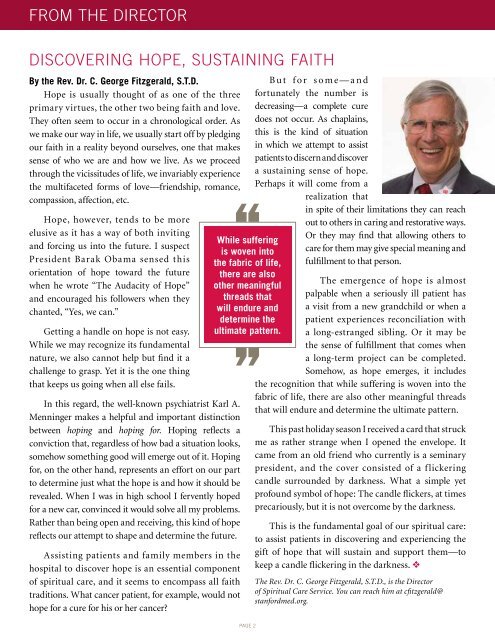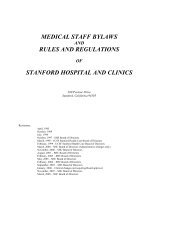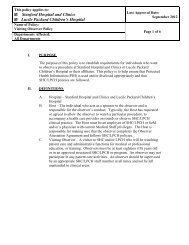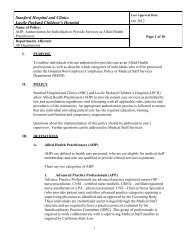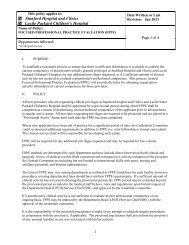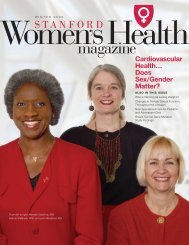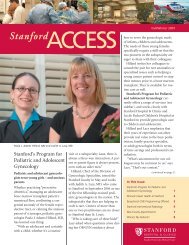SPIRITUAL CARE NOTES - Stanford Hospital & Clinics
SPIRITUAL CARE NOTES - Stanford Hospital & Clinics
SPIRITUAL CARE NOTES - Stanford Hospital & Clinics
You also want an ePaper? Increase the reach of your titles
YUMPU automatically turns print PDFs into web optimized ePapers that Google loves.
FROm THE DIRECTOR<br />
DISCOVERINg HOPE, SUSTAININg FAITH<br />
By the Rev. Dr. C. George Fitzgerald, S.T.D.<br />
Hope is usually thought of as one of the three<br />
primary virtues, the other two being faith and love.<br />
They often seem to occur in a chronological order. As<br />
we make our way in life, we usually start off by pledging<br />
our faith in a reality beyond ourselves, one that makes<br />
sense of who we are and how we live. As we proceed<br />
through the vicissitudes of life, we invariably experience<br />
the multifaceted forms of love—friendship, romance,<br />
compassion, affection, etc.<br />
Hope, however, tends to be more<br />
elusive as it has a way of both inviting<br />
and forcing us into the future. I suspect<br />
President Barak Obama sensed this<br />
orientation of hope toward the future<br />
when he wrote “The Audacity of Hope”<br />
and encouraged his followers when they<br />
chanted, “Yes, we can.”<br />
Getting a handle on hope is not easy.<br />
While we may recognize its fundamental<br />
nature, we also cannot help but find it a<br />
challenge to grasp. Yet it is the one thing<br />
that keeps us going when all else fails.<br />
In this regard, the well-known psychiatrist Karl A.<br />
Menninger makes a helpful and important distinction<br />
between hoping and hoping for. Hoping reflects a<br />
conviction that, regardless of how bad a situation looks,<br />
somehow something good will emerge out of it. Hoping<br />
for, on the other hand, represents an effort on our part<br />
to determine just what the hope is and how it should be<br />
revealed. When I was in high school I fervently hoped<br />
for a new car, convinced it would solve all my problems.<br />
Rather than being open and receiving, this kind of hope<br />
reflects our attempt to shape and determine the future.<br />
Assisting patients and family members in the<br />
hospital to discover hope is an essential component<br />
of spiritual care, and it seems to encompass all faith<br />
traditions. What cancer patient, for example, would not<br />
hope for a cure for his or her cancer?<br />
While suffering<br />
is woven into<br />
the fabric of life,<br />
there are also<br />
other meaningful<br />
threads that<br />
will endure and<br />
determine the<br />
ultimate pattern.<br />
PAGE 2<br />
But for some—and<br />
fortunately the number is<br />
decreasing—a complete cure<br />
does not occur. As chaplains,<br />
this is the kind of situation<br />
in which we attempt to assist<br />
patients to discern and discover<br />
a sustaining sense of hope.<br />
Perhaps it will come from a<br />
realization that<br />
in spite of their limitations they can reach<br />
out to others in caring and restorative ways.<br />
Or they may find that allowing others to<br />
care for them may give special meaning and<br />
fulfillment to that person.<br />
The emergence of hope is almost<br />
palpable when a seriously ill patient has<br />
a visit from a new grandchild or when a<br />
patient experiences reconciliation with<br />
a long-estranged sibling. Or it may be<br />
the sense of fulfillment that comes when<br />
a long-term project can be completed.<br />
Somehow, as hope emerges, it includes<br />
the recognition that while suffering is woven into the<br />
fabric of life, there are also other meaningful threads<br />
that will endure and determine the ultimate pattern.<br />
This past holiday season I received a card that struck<br />
me as rather strange when I opened the envelope. It<br />
came from an old friend who currently is a seminary<br />
president, and the cover consisted of a flickering<br />
candle surrounded by darkness. What a simple yet<br />
profound symbol of hope: The candle flickers, at times<br />
precariously, but it is not overcome by the darkness.<br />
This is the fundamental goal of our spiritual care:<br />
to assist patients in discovering and experiencing the<br />
gift of hope that will sustain and support them—to<br />
keep a candle flickering in the darkness. v<br />
The Rev. Dr. C. George Fitzgerald, S.T.D., is the Director<br />
of Spiritual Care Service. You can reach him at cfitzgerald@<br />
stanfordmed.org.


